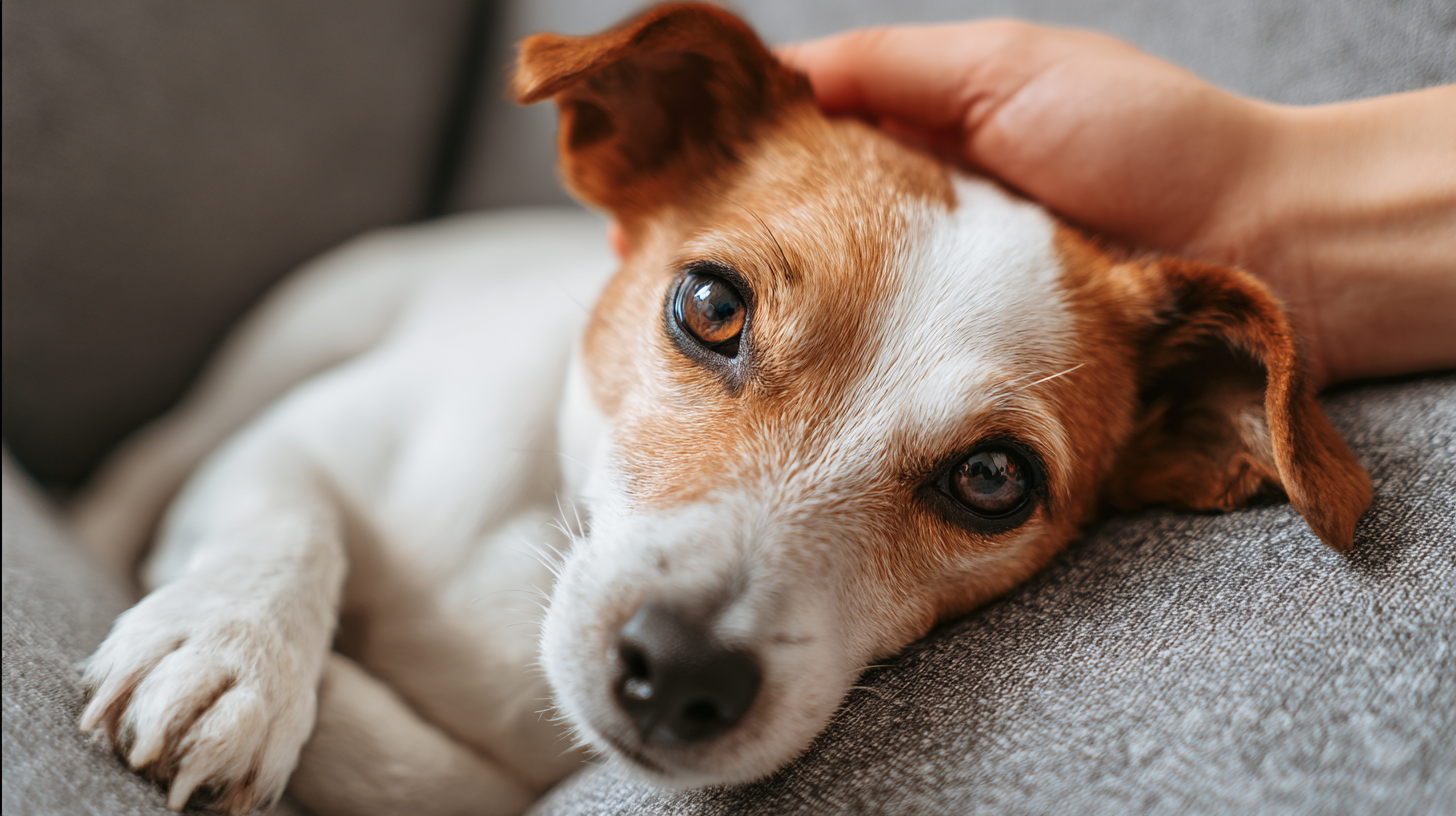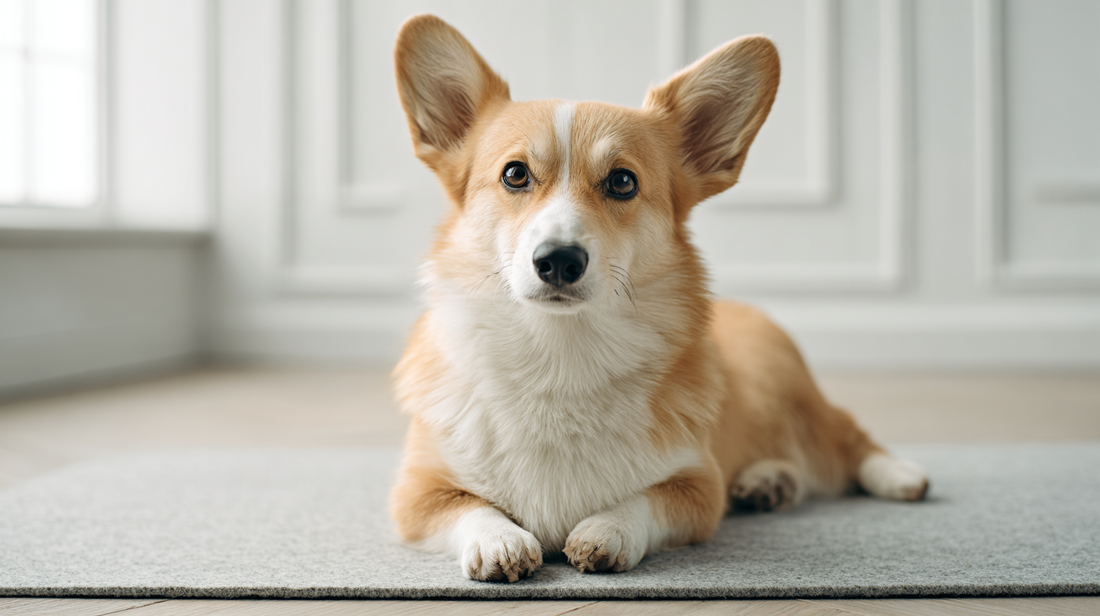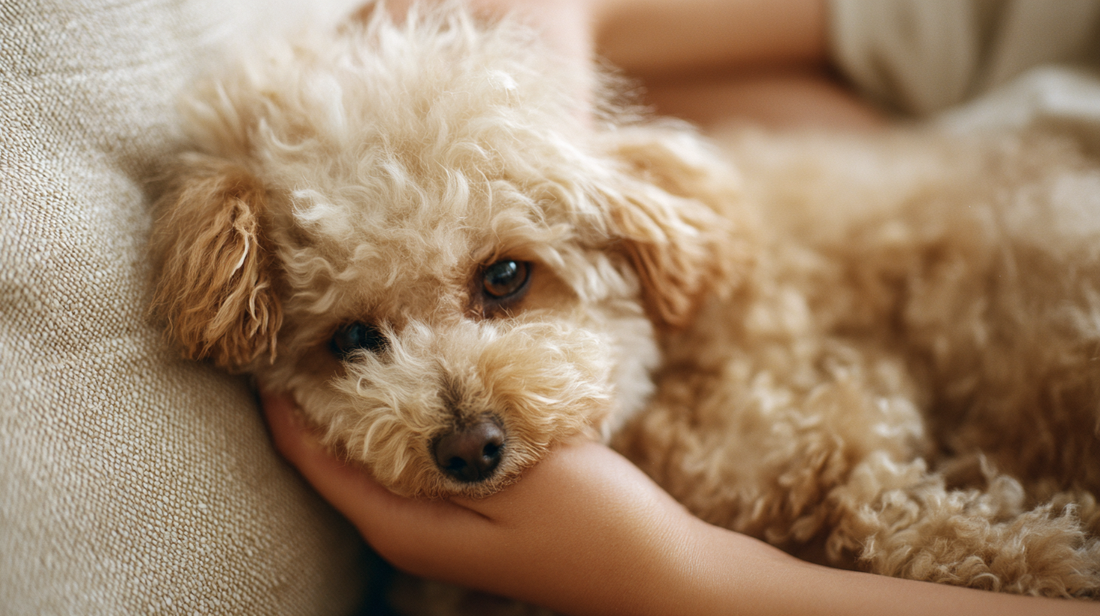As a pet owner, you share a unique bond with your dog, viewing them as an integral family member. When your companion shows distress, anxiety, or fear—including your dog's anxiety, which is a common challenge for many pet owners—you naturally seek solutions to restore their peace. Helping your dog become calm, or achieving a true dog calm, is an important goal for both their happiness and your own. Whether your dog struggles with reactivity on walks, dreads thunderstorms, or simply can’t settle in the evening, understanding how to calm a dog down is vital for their wellbeing and your relationship. Achieving sustained calmness isn’t just about managing unwanted behavior—it’s about addressing your dog’s mental and emotional health as seriously as their physical health. As an experienced veterinarian, I’ll guide you through practical, evidence-based strategies rooted in canine behavior science to help you foster a truly calm dog.
Summary
Why your dog can't relax: Understanding the stress response
To effectively help your pet, you first need to understand the science behind their emotional state. Stress occurs when stimuli threaten your dog’s optimal state, causing them to respond in an effort to re-establish comfort.
When your dog perceives threats—whether real (like an injury) or perceived (like loud noises or unfamiliar humans)—their body activates the stress system, preparing them to cope through “fight or flight” responses. The dog's body may show physical signs of stress, such as tense muscles, trembling, or changes in posture, as it reacts to these threats. If they cannot escape the stressor, or if the stress becomes prolonged, the resulting psychological distress becomes physically taxing, risking both their physical and psychological health.
Understanding body language is crucial for recognizing anxiety in your pet. Your dog constantly signals their emotional state, but these signs can be surprisingly subtle. As veterinarians, we emphasize recognizing the Ladder of Aggression—a sequence showing increasing stress levels in your dog. Many owners focus only on extreme signs like growling or biting, but these are actually last resorts, used when earlier, subtler attempts to communicate have been ignored.
Watch for these signs of stress in your dog
Here are examples of signs of unease in your dog:
Appeasement gestures: yawning, blinking, lip licking (when not eating), or turning away
Avoidance: walking away, crouched posture, tucked tail, or lying with a leg up
Increased vigilance: stiffening, intense staring, or pacing
Recognizing these cues allows you to intervene early—before your dog feels compelled to escalate their defensive behavior.

How to calm a stressed dog immediately: Behavioral first aid
When your dog faces immediate distress from a trigger, your goal is to interrupt the stress cycle and safely increase their sense of control. These actions are designed to reduce anxiety and help your dog feel more secure. This “behavioral first aid” requires swift action combined with a calm demeanor on your part.
First step: avoid punishment. Harsh tones, pointing, or physical corrections will only increase your dog’s distress and escalate the problem. Your dog is acting from fear or anxiety, not defiance. Instead, focus on these two key actions:
Change the environment and create distance
If your dog is anxious, they’re motivated to avoid the unpleasant stimulus. This is often due to their fears, which can make certain situations or triggers overwhelming for them. Give them that option. Move your dog away from the trigger to a distance where they can cope and relax.
This might mean calmly leaving a dog park, moving to another room when visitors arrive, or using a leash to guide them away from overwhelming situations. By preventing trigger exposure, you reduce the practice of unwanted behaviors and prevent emotional escalation.
Use low-stress handling and positive association
When handling your nervous dog, approach them indirectly, avoid looming or staring, and use slow, smooth movements. Use their name in a calm voice (not high-pitched or excited).
Once you’ve removed the immediate threat or created sufficient distance, introduce a powerful tool: the Conditioned Emotional Response (CER). This technique pairs the perceived threat (at low levels) with something highly rewarding for your dog, like high-value treats.
If your dog is too worried to take the treat, they’re still too close to the stressor—you need to move further away. Ask your dog to sit and immediately reward them with a treat, creating a positive emotional change that alters their view of the situation. These techniques help your dog become more relaxed, making it easier for them to feel comfortable and display calm body language.

Building long-term calmness: Strategies for sustained peace
Sustained calmness is a skill that you need to teach and reinforce throughout your dog’s life. The foundation of this long-term success relies on positive reinforcement training and creating a predictable, safe environment for your pet. These strategies not only promote calm behavior but also help maintain a healthy dog by supporting their overall well-being.
Positive reinforcement and predictability
Positive reinforcement involves rewarding your dog’s desirable behaviors with treats or praise, which increases the likelihood of those behaviors happening again. Taking time to train your dog through regular training sessions not only provides mental stimulation but also helps build calmness and predictability. This is the most humane and effective teaching method available to you. An essential component is predictability.
If you constantly send mixed messages to your dog—for example, sometimes allowing them on furniture, sometimes scolding them—they become anxious, which can lead to aggressive or frustrated responses.
You should establish a consistent relationship by asking your dog to perform a simple action like “sit” before every interaction—whether they want food, attention, or to go outside. This strategy clarifies communication, calms your dog by setting clear expectations, and reinforces that quiet, calm behavior earns rewards. This approach helps your dog develop self control over short periods, which you can gradually increase as they master staying calm.
Training as mental stimulation and empowerment
Training isn’t just for tricks—it’s a form of mental stimulation that improves your dog’s welfare by reinforcing their sense of control. Training is also a way of exercising your dog’s mind, helping to keep them mentally fit and engaged. Teaching your dog basic obedience commands (sit, stand, down) enables easier, lower-stress handling in daily life and during vet visits.
For example, cooperative care training teaches your dog to perform a “chin rest” or allow handling of their paws, using positive reinforcement to turn potentially fearful experiences (like grooming or nail trims) into comfortable, engaged activities.
Training also provides exercise for your dog’s mind, which can be as tiring as physical exercise. A mentally stimulated dog is less likely to display excess energy or develop problematic behaviors from boredom. Teach your pup new commands, practice scent work with toys, or use puzzle feeders during feeding times.
Environmental management
A well-managed environment reduces background stress for your dog. You should ensure your dog's needs are met through enrichment activities and exercise. Use management tools like crates or baby gates to create safe spaces for your pet.
If your dog struggles with separation anxiety when you leave, purposefully ignore "pushy" behaviors (like whining or pawing) while rewarding calm, quiet behaviors. This teaches your dog that they get attention on your schedule, not their demands.
Create a designated calm space in your house where your dog can retreat—perhaps with a comfortable blanket, calming music, and their favorite toys. Many dogs benefit when you play music specifically designed for animals, as studies show certain sounds can reduce stress and promote relaxation in your pet.

How to calm a dog down during specific situations
Different scenarios require tailored approaches to help your dog remain calm: Playing with your dog, such as engaging in fetch or tug-of-war, can be an effective way to help them relax and reduce stress in many situations.
Managing anxiety around other dogs and animals
If your dog's anxiety manifests around other dogs or other animals, start by maintaining distance. Dogs react differently to social situations—while some puppies are naturally social, others need gradually increased exposure.
During walks, if you notice your dog watching other animals tensely, redirect their attention with treats before they escalate. Reward any moment your dog acknowledges another dog calmly. Over time, you can decrease the distance as your dog learns that other animals aren't threats.
Reducing stress during car rides and grooming
Car rides and grooming sessions commonly trigger anxiety in dogs. For car travel, start with short periods of sitting in your parked vehicle with treats and play, gradually building to brief drives. Always ensure proper restraint for your dog's safety.
For grooming, introduce tools slowly—let your dog smell brushes or clippers while you reward calm investigation. Break grooming into manageable sessions, using treats and praise liberally throughout.
Calming your hyper dog
A hyper dog often lacks adequate outlets for energy. You should ensure your dog gets sufficient physical exercise—walks, playtime, or interactive play with toys. But remember: a tired dog isn't just physically exercised; they need mental challenges too.
Teach your dog new behaviors, practice obedience in different locations, or engage them in scent games. When your pup does settle, immediately reward this quiet behavior, even if it's brief. Gradually increase the duration you expect them to sit or lie calmly before rewarding.

What is the 3-3-3 rule for dog anxiety?
The 3-3-3 rule describes your dog's adjustment timeline when entering a new environment:
3 days: your dog may feel overwhelmed, possibly not eating normally, showing changes in appetite, and feeling generally uncomfortable
3 weeks: they start settling into routines, showing more of their true personality and feeling more comfortable in their surroundings
3 months: finally feeling at home, building trust with you, and forming secure bonds
This rule is particularly helpful when you're working with adopted dogs or puppies adjusting to new homes. Understanding this timeline helps you manage your expectations and demonstrates the benefit of patience. Don't expect your dog to instantly feel comfortable— give them time to adjust while you maintain consistent, positive routines.

At what age do dogs calm down?
Many types of dogs mature at different rates, which is important for you to understand. Generally, dogs begin calming between 1-3 years as they transition from puppyhood to adulthood. However, your individual dog varies significantly by breed, size, and temperament. High-energy breeds may not fully settle until 2-4 years old, while calmer breeds might mature earlier.
Importantly, calmness isn't just about your dog's age—it's shaped by training, environment, socialization, and health. Without proper mental stimulation, exercise, and training, even senior dogs may remain reactive or restless. Conversely, young puppies receiving excellent training and appropriate outlets for energy often display impressive self control.

What is the 7-7-7 rule for dogs?
While less widely recognized than the 3-3-3 rule, some trainers reference a 7-7-7 approach for behaviour modification that you can apply:
7 seconds: how long to wait before rewarding a behavior to ensure clarity for your dog
7 repetitions: minimum practice needed for your dog to begin learning a new behavior
7 days: timeframe for establishing a new routine or habit with your dog
This rule emphasizes the importance of consistency and patience in your training efforts. Whether you're teaching your dog to sit calmly or addressing barking, repeated practice over days—not just one session—creates lasting change. The form of practice matters too: short periods of focused training beat marathon sessions that exhaust both you and your pet.
When to call your pet health expert
While behavioral strategies are powerful tools, some dogs require additional support. If your dog's anxiety is severe, generalized, or unresponsive to environmental changes and training, you should seek your pet health expert help.
Rule out medical issues
Behavior changes, including restlessness or aggression, can be clinical signs of underlying disease, pain, or neurological problems in your dog.
Your dog's body may be communicating discomfort that manifests as anxiety—for example, arthritis causing fear during walks or pressure sensitivity making them reactive to touch.
Other ways to support your dog's wellbeing
Beyond direct training, consider these approaches to reduce stress and support your dog’s overall health:
Consistent routines: regular feeding, walk, and playtime schedules provide security for your dog
Appropriate socialization: controlled, positive experiences with various humans, animals, and environments
Physical contact: many dogs find gentle massage or pressure (like anxiety wraps) calming
Enrichment activities: rotate toys, provide puzzle feeders, engage your dog in nose work
Calm energy: dogs read our emotions—when you remain calm, they’re more likely to mirror that state
Talk to your dog: speaking to your dog in a calm voice can help soothe and reassure them, as dogs often respond positively to familiar sounds and gentle communication

Empowering you and your dog to stay calm
Learning how to calm a dog down is an investment in their health and your relationship. By recognizing subtle signs of distress in your dog—from tongue flicks to tucked tails—you can intervene proactively, transforming potential conflicts into guidance moments.
Remember, consistency and predictability build confidence in your dog. Through low-stress handling and rewarding calmness with positive reinforcement, you don't just manage unwanted behaviors—you actively build a more secure, balanced pet.
Whether you're dealing with a fearful rescue, an energetic pup, or simply wanting your dog to settle in the evening, these evidence-based strategies provide you with a roadmap. Some dogs respond quickly; others need weeks or months of patient work from you. Your individual dog determines the pace, but with dedication, professional support when needed, and commitment to calm your dog through positive methods, you ensure they lead lives that are physically, mentally, and emotionally thriving.
This collaborative approach between you, your pet, and your pet health expert creates the foundation for lasting tranquility and a deeper bond with your beloved companion.
The information in this article is based on the following scientific publications:
- Elliott, J., & Grauer, G. (Eds.). (2006-2007). BSAVA Manual of Canine and Feline Nephrology and Urology (2nd ed.). BSAVA Publications.
- Villiers, E., & Blackwood, L. (Eds.). (2005). BSAVA Manual of Canine and Feline Clinical Pathology (2nd ed.). BSAVA Publications, Gloucester
- Horwitz, D. F., & Mills, D. S. (Eds.). (2009). BSAVA Manual of Canine and Feline Behavioural Medicine (2nd ed.). BSAVA Publications, Gloucester
- Harvey, A., & Tasker, S. (Eds.). BSAVA Manual of Feline Practice: A Foundation Manual. BSAVA Publications
- Rendle, M., & Hinde-Megarity, J. (Eds.). (2022). BSAVA Manual of Practical Veterinary Welfare (1st ed.). BSAVA Publications.
Looking for a solution? Start here
Stylla Calmness for dogs
Supports relaxation and emotional balance with amino acid-based formulation
- Promotes emotional balance and relaxation
- Helps maintain balanced behaviour
- Supports healthy physiological equilibrium
Made in Switzerland with strict quality standards





